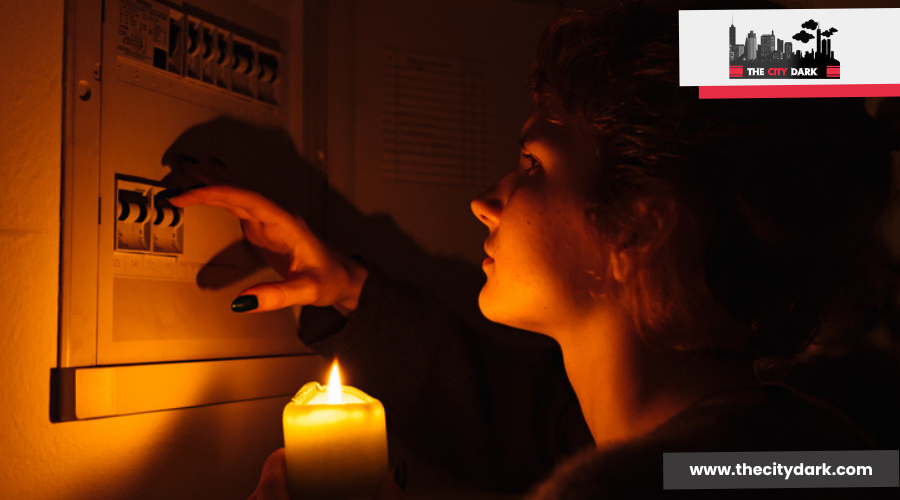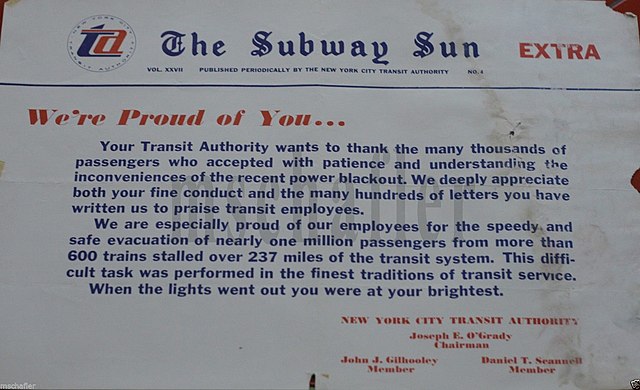History's 10 Most Notorious Blackouts

When you think about the most notorious blackouts in history, you realize they're more than inconvenient power outages. Each event, from the 1965 Northeast Blackout to the 2021 Texas Winter Storm, reveals critical flaws in our infrastructure and preparedness. These blackouts have plunged millions into darkness and triggered significant social and economic upheaval. What causes these massive power failures, and how have they shaped our approach to energy resilience today? Let's explore the intricate stories behind these ten notorious blackouts and uncover the lessons learned from each.
Northeast Blackout (1965)

The Northeast Blackout of 1965 remains one of history's most extensive power outages, impacting over 30 million people across eight U.S. states and parts of Canada for up to 13 hours. This significant disruption was caused by a human error in the power grid protection system, leading to a catastrophic cascade of failures within the electrical network.
In New York City, approximately 800,000 people were stranded due to subway disruptions. The emergency response was rapid and extensive, involving the deployment of 10,000 National Guardsmen and 5,000 off-duty police officers to maintain order and assist those affected.
The incident highlighted critical vulnerabilities in electrical grid management. It underscored the necessity of a reliable electrical network and prompted significant changes to prevent future occurrences. In response, new metering and monitoring systems were implemented to better manage the grid and avoid widespread failures.
The Northeast Blackout serves as a stark reminder of how a single human error can disrupt millions of lives, emphasizing the need for robust and resilient infrastructure.
New York City Blackout (1977)
View this post on Instagram
The New York City blackout of July 13-14, 1977, caused by a lightning strike, left the city in turmoil for nearly 25 hours. The event led to widespread looting and vandalism, resulting in significant property damage and the largest mass arrest in the city's history. The economic impact was substantial, costing approximately $300 million. This incident prompted changes in emergency response protocols to mitigate the risk of future blackouts.
Catalyst for Urban Unrest
Imagine a sweltering July evening in 1977 when New York City was plunged into darkness, igniting a powder keg of pent-up frustrations among its residents. This notorious blackout, triggered by a lightning strike, exposed the fragility of the city's power grid. The aging infrastructure and lack of maintenance rendered the city vulnerable, leading to nearly 25 hours of chaos.
The blackout didn't just leave 9 million residents without power; it sparked widespread urban unrest. Economic losses soared to around $300 million as looters took advantage of the darkness to vandalize and rob businesses. This event underscored several vital points:
- Infrastructure Vulnerabilities: The city's aging power grid couldn't withstand the lightning strike, revealing significant maintenance issues.
- Economic Impact: The financial damage from the blackout was devastating, delaying the city's recovery.
- Emergency Preparedness: The chaos highlighted the need for better emergency response plans.
- Social Tensions: The blackout acted as a catalyst, exposing underlying social and economic frustrations.
In the aftermath, the emphasis on improving emergency preparedness and updating urban infrastructure became essential to prevent such a catastrophe from recurring.
Looting and Vandalism Surge
As darkness enveloped New York City, the blackout of 1977 rapidly descended into chaos, marked by rampant looting and vandalism. The power outage, lasting nearly 25 hours, created an atmosphere ripe for criminal activity. Looters targeted approximately 1,600 shops, particularly those selling electronics and clothing, leading to an estimated economic loss of $20 million. This was a significant blow to urban areas already facing economic challenges.
The chaos extended beyond looting to include widespread vandalism. An estimated 1,000 fires were set, causing extensive property damage across numerous neighborhoods. The city's emergency response teams were overwhelmed, struggling to manage the widespread disorder. Authorities made 3,776 arrests, marking the largest mass arrest in New York City's history.
The blackout underscored serious vulnerabilities in urban areas, raising urgent questions about the need for improved emergency response and public safety measures. The scale of looting and vandalism during this period highlighted how quickly societal order can break down, leading to considerable economic and social consequences.
Long-term Economic Impact
The long-term economic impact of the 1977 blackout on New York City was both profound and far-reaching. The city faced an estimated $300 million in economic damage due to looting, arson, and vandalism. This catastrophic event led to significant hardships for local businesses, with around 1,600 stores damaged or destroyed, pushing some neighborhoods into a long-term decline.
The economic consequences extended beyond immediate damages:
- Social unrest: The blackout resulted in 3,776 arrests for looting, highlighting the social instability that can occur during prolonged power outages.
- Insurance claims: Businesses filed tens of millions of dollars in insurance claims, leading to higher premiums and further financial strain on the local economy.
- Emergency response: The incident prompted a critical reevaluation of the city's emergency response strategies to better manage such crises in the future.
- Infrastructure investment: The blackout underscored the need for substantial infrastructure investment to prevent similar failures, influencing long-term city planning and budgeting.
These factors created a ripple effect, exacerbating the city's economic challenges and exposing vulnerabilities in its emergency and infrastructural systems. Understanding these impacts underscores the complexity and severity of the 1977 blackout's legacy.
Quebec Blackout (1989)
On March 13, 1989, millions of Quebec residents faced an abrupt and extensive blackout due to a geomagnetic storm. This storm induced electrical currents that overwhelmed power lines, causing systemic failures across the transmission network and affecting approximately 6 million people. The event exposed significant vulnerabilities in Quebec's electrical grid and underscored the critical need for monitoring space weather.
The blackout paralyzed Quebec, and severe winter weather complicated recovery efforts. Despite these challenges, engineers and technicians managed to fully restore power within 9 hours. This incident highlighted the grid's susceptibility to geomagnetic disturbances and prompted substantial investments in protective measures.
The 1989 Quebec blackout serves as a stark reminder of the interconnectedness between space weather and terrestrial infrastructure. It emphasized the necessity for robust systems to protect the electrical grid from natural phenomena. Consequently, this event led to advancements in technology and protocols aimed at minimizing the likelihood and severity of future outages.
Southern Brazil Blackout (1999)
You might remember the Southern Brazil blackout of 1999, which left roughly 97 million people without power for several hours. A lightning strike on a transmission line triggered the failure of the Itaipu hydropower plant, revealing significant vulnerabilities in the nation's energy infrastructure. Major cities such as São Paulo and Rio de Janeiro came to a standstill, underscoring the urgent need for infrastructure upgrades and investments in alternative energy sources.
Widespread Infrastructure Failure
The Southern Brazil Blackout of March 11, 1999, exposed the fragility of Brazil's energy infrastructure, leaving approximately 97 million people without power for six hours. The blackout was triggered by a lightning strike on a critical electricity substation, revealing significant vulnerabilities in the country's reliance on hydroelectric power and outdated transmission systems. Major cities like São Paulo and Rio de Janeiro were severely affected, with public transportation halted and massive traffic jams causing widespread chaos.
The power outage led to social unrest and serious public safety concerns. Military police were deployed to prevent looting and maintain order, highlighting how precarious public safety becomes during such crises. This incident underscored the urgent need for infrastructure modernization and the development of alternative transmission routes to enhance grid reliability.
Key points include:
- Millions affected: Around 97 million people experienced significant disruption.
- Infrastructure weaknesses: The blackout exposed the vulnerabilities of outdated transmission lines and over-reliance on hydroelectric power.
- Social unrest: The power loss led to increased social unrest and public safety challenges.
- Need for modernization: The event emphasized the critical need for investment in modernizing Brazil's energy infrastructure to avert future crises.
This blackout was not merely an inconvenience; it was a stark warning of an impending energy crisis.
Prolonged Restoration Efforts
The Southern Brazil blackout of March 11, 1999, not only exposed weaknesses in the country's energy infrastructure but also underscored the extensive efforts required to restore normalcy. Approximately 97 million people across major cities like São Paulo and Rio de Janeiro were affected. Public transport systems halted, severe traffic jams ensued, and airports closed, leading to widespread chaos. The military police intervened to prevent looting and maintain public safety.
The blackout highlighted significant vulnerabilities in Brazil's aging energy infrastructure, particularly its dependence on hydroelectric power. Restoration efforts were complex due to the interdependence of various systems. The power outage disrupted water services and emergency response capabilities, making it a multifaceted challenge to restore normal operations.
The incident spurred calls for substantial investment in infrastructure upgrades. Modernizing Brazil's energy systems became imperative to enhance resilience against future outages. The restoration process served as a wake-up call, emphasizing the need for robust infrastructure to prevent such widespread disruptions in the future.
Massive Population Impact
On March 11, 1999, a catastrophic blackout plunged 97 million people into darkness across Southern Brazil, marking one of the largest blackouts in history at that time. The massive population impact was triggered by a lightning strike on a critical electricity substation, leading to the failure of the Itaipu hydropower plant to support the electrical load. Major cities such as São Paulo and Rio de Janeiro were severely affected, resulting in significant disruptions.
The blackout's repercussions were extensive:
- Public Transport: Trains and buses came to a halt, leaving millions of commuters stranded and immobilizing urban areas.
- Public Safety: The absence of streetlights and security systems caused a surge in crime rates, necessitating the deployment of military police to maintain order.
- Emergency Services: Hospitals and emergency services faced overwhelming challenges, struggling to function without electricity.
- Energy Infrastructure: The event exposed critical vulnerabilities in the energy infrastructure, underscoring the urgent need for modernization and investment in alternative transmission routes.
For six hours, the blackout starkly revealed the fragility of Brazil's energy system and the severe consequences of its failure. The affected population experienced firsthand the chaos that ensues from a lack of electricity, highlighting the essential need for robust and resilient energy systems.
Northeast Blackout (2003)
On August 14, 2003, the Northeast Blackout plunged approximately 50 million people across the U.S. and Canada into darkness, marking it as the second-largest blackout in history. The massive power outage was triggered by a software bug that failed to alert operators about rising voltage levels. Consequently, transmission lines came into contact with trees, leading to cascading failures across the North American electrical grid.
The power outage lasted for about 2 to 4 hours in most areas, but some locations experienced it for up to 24 hours. The economic losses were staggering, estimated to be around $6 billion. Businesses halted operations, transportation systems were disrupted, and emergency services struggled to operate effectively.
In the blackout's aftermath, significant changes were made to improve grid reliability. These included enhanced communication protocols and stricter maintenance schedules for transmission lines to prevent future failures. The Northeast Blackout of August 14 served as a stark reminder of the vulnerabilities within the North American electrical grid, prompting an overhaul of safety and operational standards across the industry. This event reshaped the approach to power grid management and reliability.
India Blackout (2012)
Now let's turn to the India Blackout of 2012, the largest in history, which left 670 million people without electricity. Grid overload, caused by states drawing excessive power and weak infrastructure, led to widespread outages. This event halted trains, disrupted traffic signals, and forced the cancellation of medical surgeries, with 38% of India's power generation going offline. The resulting public anxiety and chaos were palpable.
Grid Overload Crisis
The India blackout on July 30-31, 2012, stands as a monumental crisis, affecting around 670 million people—nearly 10% of the world's population. This power outage, the worst in history, occurred due to a grid overload and inadequate maintenance. On July 30, the northern grid collapsed, plunging regions into darkness for up to 14 hours. The situation worsened on July 31 when multiple grids—Northern, Western, Eastern, and North-Eastern—failed, resulting in a widespread blackout.
Essential services were severely disrupted. Train services came to a halt, traffic signal failures created chaos, and even surgical operations were canceled. The blackout highlighted India's critical need to address its power generation and distribution infrastructure.
Key points to evaluate:
- Scale of Impact: Affected 670 million people, nearly 10% of the global population.
- Duration: The initial blackout lasted up to 14 hours.
- Service Disruptions: Halted trains, failed traffic signals, and canceled surgeries.
- Systemic Issues: 38% of India's power generation capacity went offline, prompting calls for a $400 billion grid revamp.
This crisis underscored the urgent necessity for major infrastructural improvements to prevent future grid overloads and power outages.
Widespread Power Loss
India's blackout on July 30-31, 2012, highlighted significant vulnerabilities in the nation's electricity infrastructure, affecting approximately 670 million people. The Northern grid failed for up to 14 hours on July 30, followed by a subsequent outage involving multiple grids on July 31 that lasted several hours.
Critical factors contributing to this massive blackout included states overdrawing electricity and the failure of Under Frequency Relays (UFRs) due to inadequate maintenance. The power outage caused widespread chaos: trains halted, leaving millions stranded, traffic lights went dark, creating dangerous road conditions, and hospitals had to cancel surgeries, endangering lives. The scale of the disruption made it one of the most notorious blackouts in history.
Investigations emphasized the necessity for a $400 billion overhaul of India's power grid to prevent future occurrences. This incident underscored the urgent need for robust infrastructure to support the country's growing energy demands and mitigate the risks of widespread power losses.
Public Anxiety Surge

Amid the chaos of India's July 2012 blackout, public anxiety surged as millions grappled with the sudden power disruption. The worst outage in recent history left approximately 670 million people in the dark for up to 14 hours, causing widespread panic and uncertainty. Key infrastructure suffered immensely; halted trains and non-functional traffic signals created chaos on the streets, while hospitals faced dire consequences, including the cancellation of essential surgeries.
This situation highlighted the fragility of India's power distribution system, prompting urgent calls for reform. Key factors contributing to the heightened public anxiety included:
- Infrastructure Disruption: Trains stopped mid-journey, and traffic signals went dark, leading to gridlock and accidents.
- Hospitals in Crisis: Critical surgeries were canceled, jeopardizing patient lives and causing immense stress.
- Extended Power Outage: With 38% of India's power generation offline, the duration and scale of the blackout amplified fears.
- Need for Reforms: The blackout underscored the necessity for a $400 billion investment to revamp the power grid and prevent future occurrences.
Ultimately, this massive power outage exposed significant vulnerabilities in India's power grid and stressed the urgent need for thorough reforms to safeguard crucial infrastructure and reduce public anxiety.
Hurricane Sandy Blackout (2012)

In late October 2012, Hurricane Sandy struck the East Coast of the United States, causing one of the most extensive blackouts in recent history. The storm's high winds and flooding led to massive power outages, affecting approximately 8.5 million customers. States like New York and New Jersey experienced severe damage to their infrastructure, including substations and power lines. This resulted in prolonged power restoration efforts, with some areas remaining without electricity for over a week.
The economic impact was significant, with losses estimated at around $65 billion. Both businesses and residential areas faced substantial challenges in dealing with the blackout and the hurricane's aftermath. Emergency response was immediate, with the National Guard deployed to maintain public safety and aid recovery efforts. Utility crews from other states also assisted in the restoration of power.
Despite these efforts, the scale of the damage meant that returning to normalcy took considerable time. Hurricane Sandy's blackout serves as a stark reminder of the vulnerability of infrastructure to natural disasters and underscores the importance of robust emergency response planning.
Southwest Blackout (2011)
On September 8, 2011, the Southwest Blackout occurred, marking the largest blackout in California's history and affecting parts of Arizona and Mexico. Approximately 7 million people were impacted for about 12 hours. The blackout was caused by a series of human errors and equipment failures, including miscommunication about a power line's status and a failure to monitor the grid's operational limits.
The event exposed critical vulnerabilities in the energy infrastructure, prompting extensive investigations. The economic impact was significant, with losses estimated between $12 million and $15 million, affecting businesses and emergency services.
Key points from the Southwest Blackout include:
- Affected Population: Approximately 7 million people.
- Duration: About 12 hours.
- Causes: Human errors and equipment failures.
- Economic Losses: Estimated between $12 million and $15 million.
In response, California's Independent System Operator implemented stricter guidelines and improved grid monitoring systems to prevent future occurrences. This blackout underscored the need for better communication and operational protocols among utility companies.
Texas Winter Storm (2021)
The Texas Winter Storm in February 2021 plunged approximately 4.5 million Texans into darkness as extreme cold and ice nearly collapsed the state's electric grid. The storm's severity led to widespread power outages, affecting nearly 5 million people. The Electric Reliability Council of Texas (ERCOT), which manages the state's electric grid, implemented rolling blackouts to prevent a total grid failure, marking one of the largest power crises in U.S. history.
The economic loss from the storm was staggering, estimated at $130 billion, encompassing lost output, infrastructure damage, and widespread disruptions. Prolonged outages left many residents in critical situations, with some facing hypothermia and carbon monoxide poisoning from alternative heating sources. The storm exposed significant vulnerabilities in Texas's energy infrastructure, affecting natural gas, coal, nuclear, and renewable energy sources alike.
In response, investigations called for urgent regulatory reforms to enhance grid resilience and prevent future crises. The storm underscored the need for a more robust and weather-resistant electric grid. By addressing the weaknesses exposed during this storm, Texas can implement necessary changes to safeguard against future blackouts and economic losses.
California Rolling Blackouts (2020)
In August 2020, California experienced rolling blackouts that affected over 400,000 customers due to extreme heat and unprecedented electricity demand. The California Independent System Operator (CAISO) initiated these blackouts as a preventive measure to avoid a complete power grid collapse, an action not seen since 2001. The heatwave drove electricity consumption to over 50,000 megawatts, resulting in emergency alerts and urgent calls for energy conservation.
The blackouts lasted several hours, with some residents facing outages for up to 12 hours. This situation led to significant public frustration and raised concerns about the reliability of California's power grid. Key issues highlighted by the blackouts included:
- Extreme Heat: Record temperatures drove electricity demand to new highs.
- Grid Stability: The power grid struggled to maintain a balance between supply and demand.
- Renewable Energy: There is a need for greater investment in renewable energy infrastructure.
- Energy Storage: Enhanced energy storage solutions are crucial for future grid stability.
In response, California officials emphasized the importance of investing in renewable energy and upgrading infrastructure to ensure grid reliability. The events underscored the urgent need for advancements in energy storage and grid management to prevent future disruptions.




